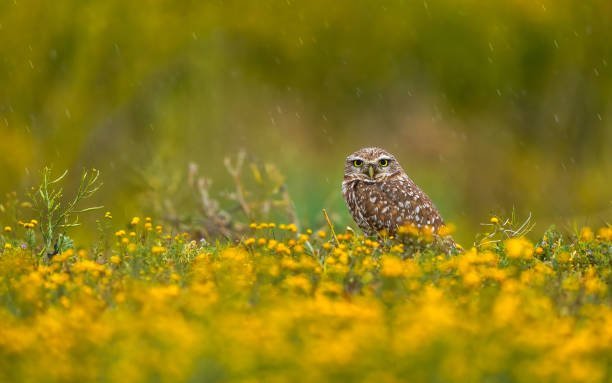How can one safely rescue an injured owl without causing further harm?

Introduction:
In this article, I’ll guide you through the delicate and compassionate process of safely rescuing an injured owl without causing further harm. Owls, with their enigmatic charm and crucial roles in maintaining ecosystem balance, are majestic birds that occasionally find themselves in distress. Whether they’ve collided with a vehicle, encountered environmental hazards, or suffered from an illness, their well-being depends on human intervention in some cases.
While the desire to assist an injured owl is noble, it is essential to approach the rescue with the utmost care and respect for these remarkable creatures. Mishandling or a lack of awareness can exacerbate their injuries or stress, inadvertently causing more harm. Therefore, understanding the proper procedures and precautions is crucial to ensure the owl’s best chance at recovery and eventual release back into the wild. This article will provide you with practical guidelines and insights into the safe and ethical rescue of injured owls, empowering you to make a positive difference in their lives while preserving their dignity in the process.
Approach calmly and quietly:
When encountering an injured owl, your initial approach is crucial. The first step is to remain calm and approach the bird quietly. Owls, even when injured, can be easily stressed and frightened by sudden, loud noises or sudden movements. This stress can exacerbate their injuries and make the rescue process more challenging. Approach the owl with slow, deliberate movements, and avoid making any sudden gestures or loud sounds that could startle it.
Maintaining a calm demeanor is essential not only for the owl’s well-being but also for your safety. Injured owls may become defensive or attempt to protect themselves, and a sudden aggressive reaction could result in harm to both you and the owl. By approaching calmly and quietly, you create a less stressful environment for the owl and reduce the risk of further injuries.
Assess the owl’s condition:
Once you’ve approached the owl safely, the next step is to assess its condition. This assessment is critical in determining the extent of the owl’s injuries and the appropriate course of action. Carefully observe the owl from a safe distance to avoid causing additional stress. Look for signs of trauma, such as disheveled feathers, blood, or visible injuries. Check if the owl is conscious and able to move its limbs. If it’s conscious, it may be able to react to your presence, so maintain your calm and quiet approach.
Assessing the owl’s condition may also involve identifying the species of owl, as different owl species have unique characteristics and requirements. Observe its size, coloration, and any distinctive features that can help with later identification. All these details will be valuable information to relay to a wildlife expert or rehabilitator who can provide guidance on the next steps.
Use gloves and a towel:
When you’re ready to make physical contact with the injured owl, it’s crucial to use protective gear, such as gloves and a towel. Owls have sharp beaks and talons, even when injured, and they may instinctively defend themselves if they feel threatened. Gloves provide protection for your hands and fingers, reducing the risk of getting scratched or bitten during the rescue.
A towel is a versatile tool in handling the owl. Gently drape the towel over the owl, covering its body while leaving its head exposed. This helps to calm the bird by limiting its visual stimuli and making it feel secure. Be extremely gentle when placing the towel over the owl, as rough handling can cause further stress and harm. If the owl is able to perch on a branch or surface, you can also use the towel to carefully wrap it and secure its wings, which can prevent it from flapping and causing further injury.
Using gloves and a towel in the rescue process not only ensures your safety but also provides a more comfortable and secure experience for the injured owl. Remember to handle the owl with the utmost care and respect throughout the process.
Secure the owl gently:
After using gloves and a towel to protect yourself and calm the owl, it’s time to secure the bird gently. Hold the owl firmly but with a delicate touch. Ensure that its wings are folded against its body to prevent flapping, which could lead to further injury. Be cautious not to exert too much pressure, especially around the chest area, as owls have delicate bone structures.
When handling the owl, it’s essential to maintain a stable and supportive grip. Avoid sudden movements or changes in posture that could startle the bird. Keep in mind that the owl is already in a state of distress due to its injuries, and any additional stress could be detrimental to its well-being.
Securing the owl gently and securely not only safeguards the bird from further harm but also facilitates the transportation process, making it less stressful for both you and the owl.
Transport in a dark, quiet container:
Transporting the injured owl to a safe location for assessment and potential treatment is a critical step in the rescue process. To ensure the owl’s well-being during transport, use a dark, quiet container. Darkness helps to keep the owl calm, as it simulates nighttime conditions, which are when owls are most active.
A cardboard box or pet carrier can serve as a suitable container. Ensure that it’s well-ventilated but free from drafts, as owls are sensitive to temperature changes. Place a soft, non-abrasive material at the bottom of the container to provide a comfortable surface for the owl to perch or lie on. Remember to keep the container clean, as sanitation is essential for the owl’s health.
Adding a towel or cloth inside the container can offer a cozy hiding place for the owl, reducing stress during transportation. Make sure the container is securely closed to prevent the owl from escaping or sustaining further injuries during the journey. Transporting the owl in a dark and quiet container minimizes stress, helping to maintain the bird’s stability and comfort throughout the rescue process.
Avoid excessive handling:
During the rescue and transportation process, it’s crucial to minimize the amount of handling the injured owl receives. Excessive handling can lead to increased stress and potentially worsen its injuries. Once the owl is secured in the container, try to limit any unnecessary contact.
Examine the owl’s condition and assess its injuries as thoroughly as possible before securing it in the transport container. Avoid repeatedly opening the container to check on the owl, as this can cause additional stress. Instead, rely on a single, well-planned assessment to gather the necessary information for the bird’s eventual treatment.
If you need to reposition the owl within the container, do so with care and gentleness. Remember that minimizing handling helps create a less stressful environment, promoting the owl’s well-being and increasing its chances of recovery.
Contact a wildlife expert or rehabilitator:
Rescuing an injured owl is a commendable act, but it’s essential to recognize that owls have specific needs and requirements that are best addressed by wildlife experts or rehabilitators. Once you’ve safely transported the owl to a secure location, it’s crucial to contact a knowledgeable professional who can provide proper care.
Wildlife experts and rehabilitators have the experience and resources to assess the owl’s injuries, offer necessary medical treatment, and determine the best course of action for its rehabilitation and release. They can also identify the owl’s species, which is important for tailoring the care to its specific needs.
In some cases, owls may require specialized care and facilities, such as those available at wildlife rehabilitation centers. These centers have the expertise to provide medical treatment, nutrition, and appropriate housing for injured owls. By contacting a wildlife expert or rehabilitator, you ensure that the owl receives the best possible care and the highest chance of returning to the wild.
Keep the owl warm and quiet:
Once you’ve secured the owl and contacted a wildlife expert or rehabilitator, it’s essential to maintain its comfort and well-being while awaiting professional help. Keep the owl in a warm and quiet environment. This is especially important as owls are highly sensitive to temperature changes and disturbances.
Maintaining a warm environment helps regulate the owl’s body temperature, as injuries can make them more susceptible to temperature fluctuations. You can achieve this by placing a heat source, such as a warm water bottle or heating pad (set on low), beneath a portion of the container, ensuring that the owl has space to move away from the heat source if needed.
Additionally, keeping the owl in a quiet environment reduces stress and helps it remain as calm as possible. Loud noises and disruptions can exacerbate injuries and lead to increased stress levels.
Conclusion:
I hope this guide has equipped you with the knowledge and confidence to safely rescue an injured owl while minimizing the risk of causing further harm. Owls, with their captivating presence and ecological significance, deserve our utmost care and respect in times of distress. The key takeaways from this discussion can make a significant difference in the outcome of such encounters.
Approaching calmly and quietly, assessing the owl’s condition, using protective gear, securing the owl gently, and providing a dark, quiet container are fundamental steps in the process. Minimizing excessive handling and promptly contacting a wildlife expert or rehabilitator ensure that the owl receives appropriate care. Keeping the owl warm and quiet during the interim is equally essential.
Remember, successful owl rescue not only aids the individual bird but also contributes to the broader conservation efforts to protect these remarkable creatures. By following these guidelines, you can be a part of the compassionate network working to safeguard owls and preserve their vital role in the natural world.










Post Comment